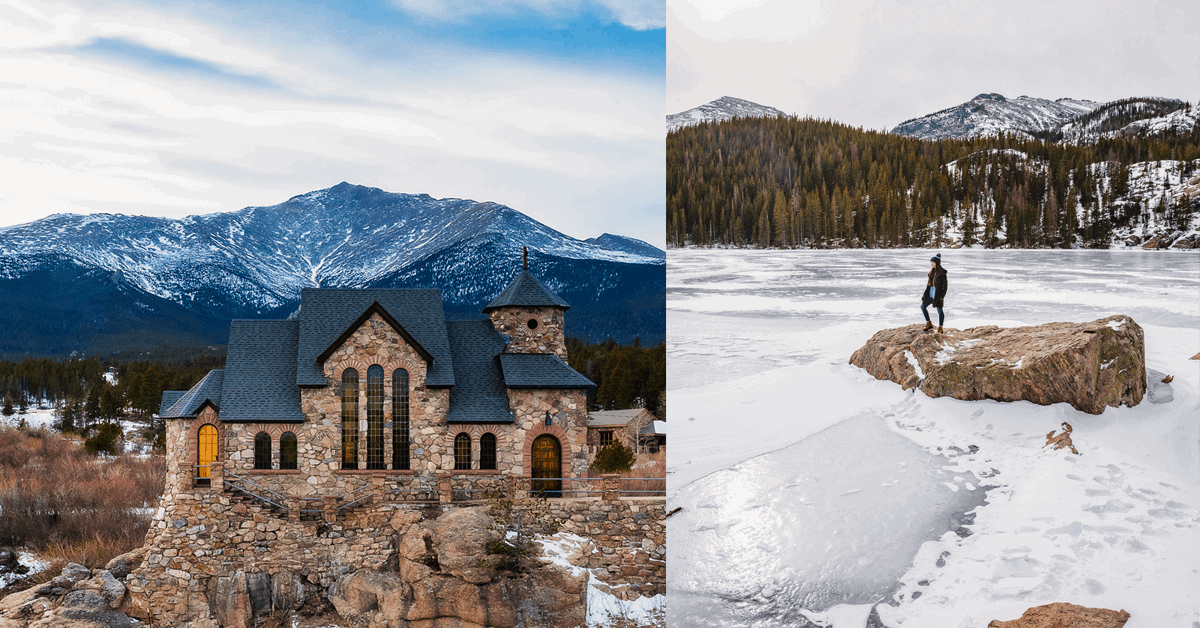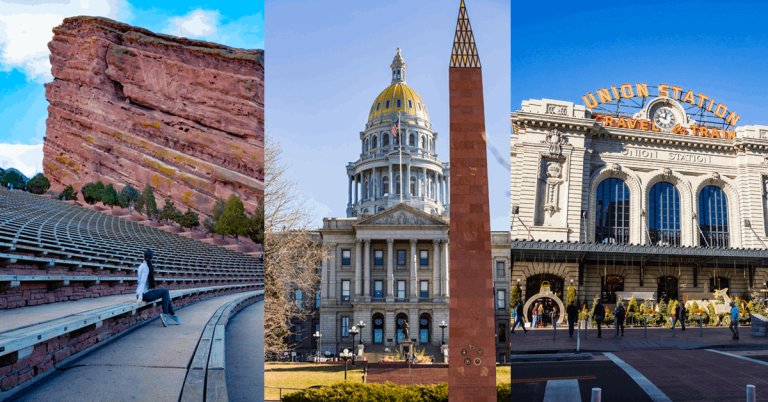Travel Tips for Visiting Rocky Mountain National Park

Visiting Rocky Mountain National Park in December
When Peter and I were compiling the list of things we wanted to do, see, eat, drink, and experience while in Colorado, visiting Rocky Mountain National Park was on that top list! We wanted to see the rocky mountains in person and we hoped to see some soaring peaks and frozen over lakes.
Open year-round and encompassing 415 square miles, this may not be the largest national park but it does feature mountains that range as high as 14,000 feet (Longs Peak), and the Rocky Mountain National Park Visitor Center is highest visitor’s center in the entire National Park System.
I can attest to its beauty during the wintertime, with its frozen lakes, white peaks, and abundant wildlife. Here are some travel tips for visiting Rocky Mountain National Park and some winter activities you can enjoy!
About The Colorado Rocky Mountains
Rocky Mountain National Park, created by President Woodrow Wilson in 1915, became the tenth park in a system that now boasts sixty. While it wasn’t until the 1930s that the park becomes more formally developed—thanks to the Civilian Conservation Corps—complete with roads, comfort stations, trails, and outbuildings.
The second wave of development occurred in the late 1960s and early 1970s, building visitor centers and ranger stations throughout the park, increasing campground capacity, and increased staffing. We found the park, the roads, and the trails to be well maintained, with plenty of signage to point us in the right direction.
While summertime is heavy tourist season, we found that there is so much to do and see during the winter at Rocky Mountain National Park.
Where are the Rocky Mountains?
If you are wondering how to get to Rocky Mountain National Park here are some directional travel tips.
The actual address of the Rocky Mountain National Park Visitor Center is 1000 US Hwy 36
Estes Park, CO 80517, which is why the directions are to Estes Park. Estes Park is the gateway to the Rockies.
Boulder to Estes Park
Our visit to Rocky Mountain National Park came after our stay in Boulder, Colorado. Our drive from Boulder to Estes Park took us just over an hour via Highway 36. However, there are plenty of options to get to this park, which is the northern part of the state.
Denver to Estes Park
From Denver to Estes Park there are three possible driving routes: You can take Highway 36 through Boulder (66 miles), Highway 66 (71 miles), or drive via the Peak to Peak Scenic Byway (108 miles). This last route is by far the slowest, but the scenery is said to be utterly fantastic.
West Colorado to the Rockies
From the West, you can take 1-70 to Highway 40 and cross to Highway 34. However, there are wintertime restrictions on this route, with closures due to snow. Make sure you check before departure.
The nearest airport to the Rocky Mountain National Park is Denver International, which is approximately 76 miles away, however, there are no trains or buses that can take you from the airport to the park. There are shuttle vans that go to nearby Estes Park, where you can find accommodations.
We took Highway 36 from Boulder to Estes Park and on the way back to boulder we drove the Peak to Peak Scenic Byway which took a lot longer. The drive is gorgeous and it does take you along some gorgeous scenery, just be prepared to drive a lot longer.
Things to do in Rocky Mountain National Park in the Winter
Winter Hiking the Rocky Mountains
There are over 350 miles of trails within the park’s boundaries, and while not all of them are open or accessible during the winter for hiking, there are plenty to choose from at the lower elevations. You can pick up a hiking map at any of the Visitor Centers, at the same time consulting with the Rangers as to your options based on the weather and snow conditions.
While visiting Visiting Rocky Mountain National Park this was the main activity that we did Seeing that we were not properly equipped to go on an epic hike we did a simple 1-mile loop around Bear Lake. The hike was really gorgeous, since it was December and very cold the lake was frozen over and you could walk on it.
The trail is pretty simple and along the path, you’ll find small waterfalls that have frozen and openings to the lake that make for some amazing photos.
Snowshoeing
This is a popular activity in Rocky Mountain National Park. All you need is some warm clothes (and preferably waterproof pants), snowshoes and poles and off you go. Snowshoeing is great exercise and allows you to explore most of the hiking trails throughout the park, many that are inaccessible for regular hiking.
Note: From January through March, there are free ranger-led snowshoe programs. Reservations are required. Check their special program page for information.
Cross-Country Skiing
Not quite as easy for a novice as snowshoeing, but with a little practice, you too could be making your way across fields of snow exploring the backcountry of Rocky Mountain National Park. You’ll need the same warm, waterproof clothing, cross-country skis and poles and you can head out and explore any part of the 415 square miles.
Sledding
Fun for the whole family, sledding is allowed in Hidden Valley. You’ll have to bring your own sled or rent one (see info below). While you may cross paths with skiers and snowboarders, they will yield the right of way. One word of warning though, sleds with metal runners are not allowed. Plastic sleds, saucers, or tubes are what you need to go roaring down the hills.
Note: Snowshoes, cross-country skis, and sleds are not available for rent within the park, but nearby Estes Park and Grand Lake both have plenty of rental shops to meet your needs.
Wildlife Sightings
Amongst the aspen and the pines, herds of elk and mule deer make their home in Rocky Mountain National Park. But during the winter months, you are more likely to get a glimpse of moose, bighorn sheep, black bears, eagles, hawks and a variety of birds.
We got lucky and came across a small herd of elk, each with large racks adorning their heads. We found them to be quite majestic beasts, seemingly without a care, hanging out in the meadow on a cool afternoon.
The best bets for viewing wildlife, according to the park’s website, are moose along the Colorado River on the west side, elk and mule deer at dusk and dawn in meadows, as well as bighorn sheep along Highway 34 and the Fall River corridor.
Rocky Mountain National Park Winter Precautions
As the official website for the park states, the weather is extreme and unpredictable, and never more so than in winter, so you do need to be prepared for bitter cold, frozen roads, snowstorms. We were there in December and while there certainly was snow on the roads, we did not encounter any issues, and there was no need for tire chains. But we may have been very lucky, so check the weather and road conditions before you head to Rocky Mountain National Park.
There is also the possibility of avalanche risk in the area. Make sure that before visiting Rocky Mountain National Park in the winter, you consult the Avalanche Forecast. This day-by-day forecast provides weather information, avalanche danger rates (from 1: low to 5: extreme), as well as a Twitter feed with up-to-the-minute reporting.
Estes Park
Adjacent to Rocky Mountain National Park on the east side is Estes Park. It is known as the base for the rockies, providing some unique places to stay, some great dining experiences and fun shopping at locally owned boutiques.
Passing through, we couldn’t help but stop and take in two institutions: the famed Stanley Hotel and Antonio’s Real New York Pizza.
The Stanley Hotel in Estes Park
Horror film buffs will recognize this hotel as the inspiration for Stephen King’s The Shining. Tucked into the hillside, this regal hotel is on the National Register of Historic Places and looks like it just stepped out of the pages of a southern gothic novel.
While we didn’t do an overnight at The Stanley, you do have your choice of staying in one of their historic rooms or they have extended stay apartments, a B&B, and even condos. The grounds are gorgeous, even in winter, and we understand that this is a popular venue for weddings—and we can see why.
The Stanley also has some really great dining options, including Table—a pop-up restaurant with guest chefs, Cascades—a steakhouse with a local vibe, Steamers Café—where we warmed up with a nice hot latte, and Whiskey Bar—an elegant haven featuring some great scotch and whiskey. (Since we were driving, we had to pass.)
And speaking of food…
Lunch at Antonio’s Real New York Pizza
I know it seems a bit odd to be eating NY pizza in the middle of Colorado, but searching for a restaurant in Estes Park we found this culinary gem had over 300 reviews and a 4.6-star rating. So how could we pass that up?
Not so easy was our decision on what to order. They have New York style round pies, New York Sicilian square pies, and Neapolitan wood-fired pies. They have 8 kinds of meat, 4 kinds of cheese, over a dozen veggies and herbs. There are 10”, 12”, 14”… all the way up to 26” pizzas.
Tip: If you come here with a crowd, think about ordering the Hell’s Kitchen Pizza. This gargantuan pie weighs about 12 pounds, is 26 inches across, and features four different types of their popular pizzas all in one: Godfather, White Garlic, Greek, and Cheese. Not for the faint of heart or those with cholesterol issues.
After lunch, we were able to wander around Estes Park and really found it to be a great little town, with a laid-back vibe. Galleries and boutiques and cute little coffee shops line the streets and it was hustling and bustling, even during winter.
We hope this post has helped you discover what you can do when Visiting Rocky Mountain National Park and has inspired you to visit it in the winter!
If you’re planning on visiting Colorado soon, make sure to also check out Denver, Aspen and Colorado Springs! Check out our guides on The Best Things to Do in Colorado Springs, The 12 Best Things to Do in Denver, and The Best Things to do in Aspen – Winter Activities for Every Traveler.
Stay Stylish,
-V






